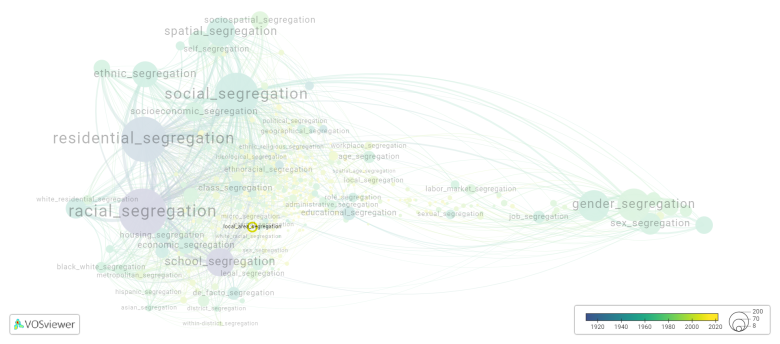Local area segregation: Difference between revisions
(Creating page) |
(Creating page) |
||
| (10 intermediate revisions by the same user not shown) | |||
| Line 1: | Line 1: | ||
===== Date and country of first publication<ref>Date and country of first publication as informed by the Scopus database (December 2023).</ref>===== | |||
2016<br> | 2016<br> | ||
United States | |||
===== Definition ===== | |||
Local area segregation refers to the phenomenon where different communities or neighborhoods within a specific locality are divided along social, economic, or racial lines. It often results in separate neighborhoods with distinct demographic characteristics, lifestyles, and opportunities. | Local area segregation refers to the phenomenon where different communities or neighborhoods within a specific locality are divided along social, economic, or racial lines. It often results in separate neighborhoods with distinct demographic characteristics, lifestyles, and opportunities. | ||
| Line 12: | Line 14: | ||
Reducing local area segregation is essential for creating more inclusive and equitable communities, where individuals from diverse backgrounds can interact, thrive, and have equal access to opportunities. Such efforts can contribute to breaking down discriminatory barriers, fostering social integration, and promoting justice in urban or suburban spaces. | Reducing local area segregation is essential for creating more inclusive and equitable communities, where individuals from diverse backgrounds can interact, thrive, and have equal access to opportunities. Such efforts can contribute to breaking down discriminatory barriers, fostering social integration, and promoting justice in urban or suburban spaces. | ||
==See also== | ==See also== | ||
==Related segregation forms== | |||
Local area segregation is frequently discussed in the literature with the following segregation forms: | |||
[[residential segregation]], [[hispanic residential segregation]], [[ethnic residential segregation]], [[hispanic segregation]], [[micro segregation]], [[hispanic white segregation]], [[rural segregation]] | |||
[[File:local_area_segregation.png|780x780px]] | |||
This visualization is based on the study [[Segregation_Wiki:About| The Multidisciplinary Landscape of Segregation Research]]. | |||
For the complete network of interrelated segregation forms, please refer to: | |||
* [https://tinyurl.com/2235lkhw First year of publication] | |||
* [https://tinyurl.com/2d8wg5n3 Louvain clusters] | |||
* [https://tinyurl.com/223udk5r Betweenness centrality] | |||
* [https://tinyurl.com/244d8unz Disciplines in which segregation forms first emerged (Scopus database).] | |||
==References== | ==References== | ||
== | ==Notes== | ||
<references /> | |||
{{NoteAI}} | |||
==Local area segregation appears in the following literature== | |||
Lichter D.T. | Lichter D.T., Parisi D., Taquino M.C. (2016). Emerging Patterns of Hispanic Residential Segregation: Lessons from Rural and Small Town America. ''Rural Sociology'', ''81''(4), 483-518. Rural Sociological Society.https://doi.org/10.1111/ruso.12108 | ||
Latest revision as of 07:17, 16 October 2024
Date and country of first publication[1][edit | edit source]
2016
United States
Definition[edit | edit source]
Local area segregation refers to the phenomenon where different communities or neighborhoods within a specific locality are divided along social, economic, or racial lines. It often results in separate neighborhoods with distinct demographic characteristics, lifestyles, and opportunities.
Local area segregation can be a consequence of various factors, including historical racial or ethnic discrimination, socioeconomic disparities, housing policies, and personal preferences. These factors contribute to the creation of divided communities where individuals from different backgrounds have limited interaction, leading to social isolation and unequal access to resources and opportunities.
Segregation can have significant impacts on individuals and communities. It perpetuates inequalities by concentrating poverty, limiting educational and employment opportunities, and reinforcing social hierarchies. It may also lead to the marginalization and stigmatization of certain groups, hindering social cohesion and fostering inequitable power relations.
Efforts to address local area segregation are multi-faceted and require a comprehensive approach. They may involve policies targeting fair housing practices, community engagement initiatives, zoning reforms, equitable distribution of resources, and educational programs promoting diversity and inclusion.
Reducing local area segregation is essential for creating more inclusive and equitable communities, where individuals from diverse backgrounds can interact, thrive, and have equal access to opportunities. Such efforts can contribute to breaking down discriminatory barriers, fostering social integration, and promoting justice in urban or suburban spaces.
See also[edit | edit source]
Related segregation forms[edit | edit source]
Local area segregation is frequently discussed in the literature with the following segregation forms:
residential segregation, hispanic residential segregation, ethnic residential segregation, hispanic segregation, micro segregation, hispanic white segregation, rural segregation

This visualization is based on the study The Multidisciplinary Landscape of Segregation Research.
For the complete network of interrelated segregation forms, please refer to:
References[edit | edit source]
Notes[edit | edit source]
- ↑ Date and country of first publication as informed by the Scopus database (December 2023).
At its current state, this definition has been generated by a Large Language Model (LLM) so far without review by an independent researcher or a member of the curating team of segregation experts that keep the Segregation Wiki online. While we strive for accuracy, we cannot guarantee its reliability, completeness and timeliness. Please use this content with caution and verify information as needed. Also, feel free to improve on the definition as you see fit, including the use of references and other informational resources. We value your input in enhancing the quality and accuracy of the definitions of segregation forms collectively offered in the Segregation Wiki ©.
Local area segregation appears in the following literature[edit | edit source]
Lichter D.T., Parisi D., Taquino M.C. (2016). Emerging Patterns of Hispanic Residential Segregation: Lessons from Rural and Small Town America. Rural Sociology, 81(4), 483-518. Rural Sociological Society.https://doi.org/10.1111/ruso.12108
